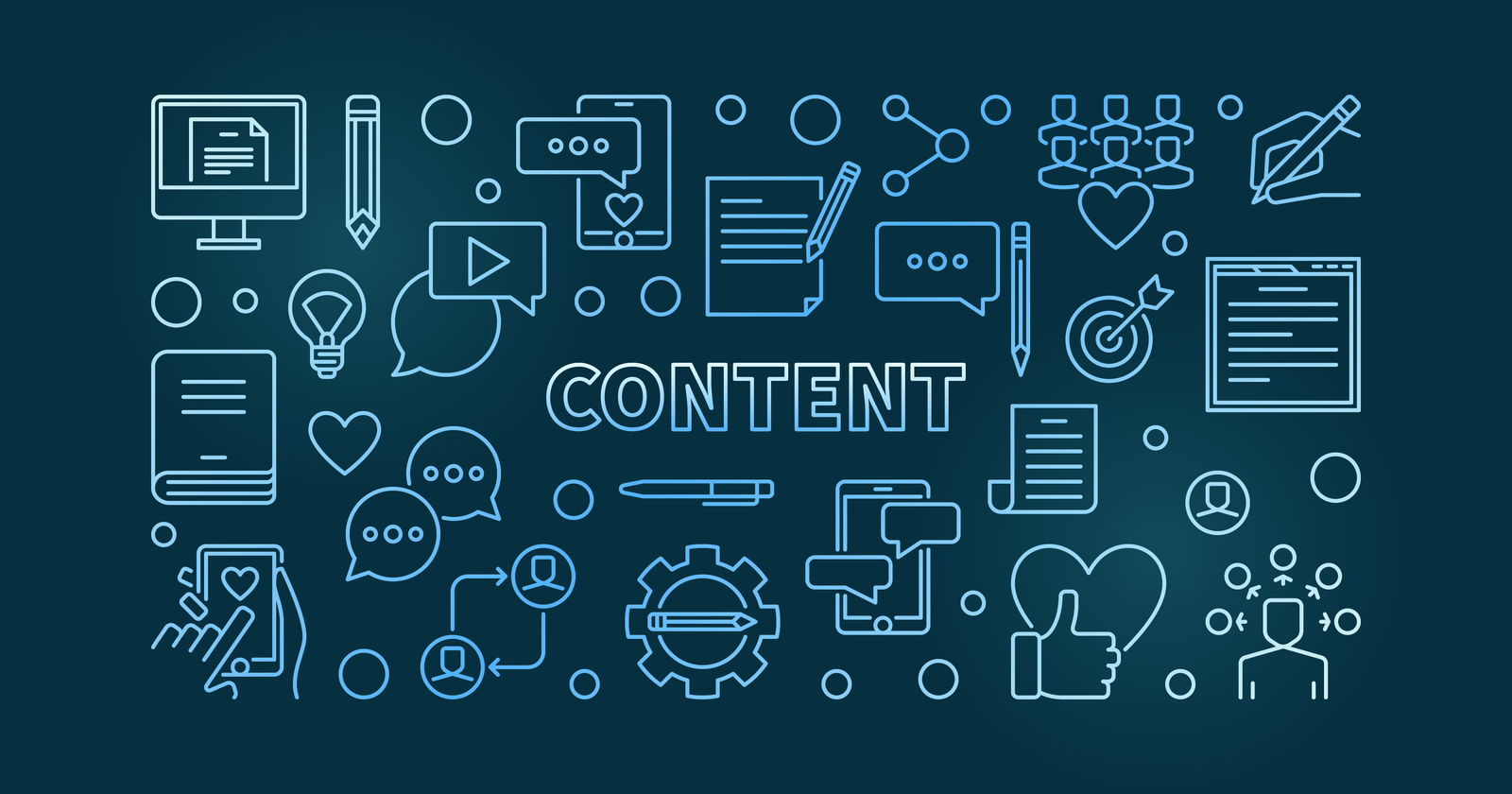Modern SEO, aside from ensuring the creation of structured, search-friendly documents, is all about creating relevant, contextual content your desired audience wants to read, like, and share.
As such, and in light of what Mark Schaefer in 2014 properly called Content Shock, you better make sure it’s relatively unique and entertaining as well.
Your content must stand out from all the other content people are bombarded with.
Optimized content marketing campaigns weave stories together through multiple pieces of content and content types.
Think of an email newsletter and complementary social posts tied to a blog post that links to a relevant landing page, video, and/or podcast with a value-added call to action.
Via the lens of our new normal, all brands are well-advised to measure their content against the human value it delivers to its consumers.
In other words, content marketing becomes context marketing.
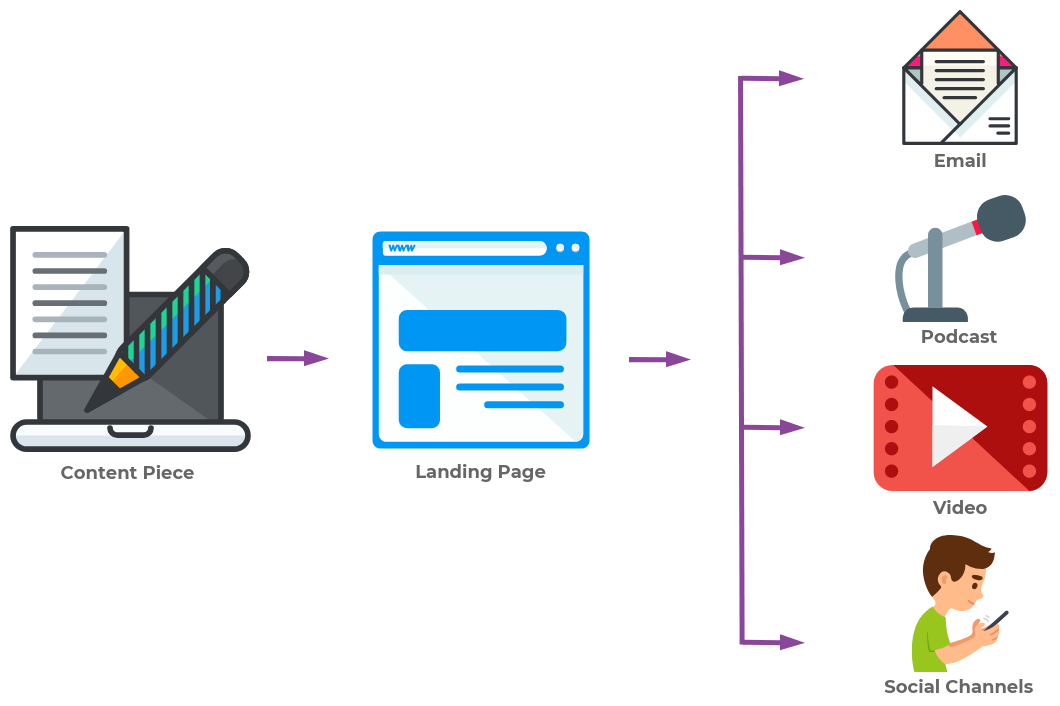
As BKA Content, in a recent Search Engine Journal Content Marketing Guide, succinctly points out:
“…awesome content – that is, great content marketing – is legitimately engaging. Your audience doesn’t need to be convinced to read your content.”
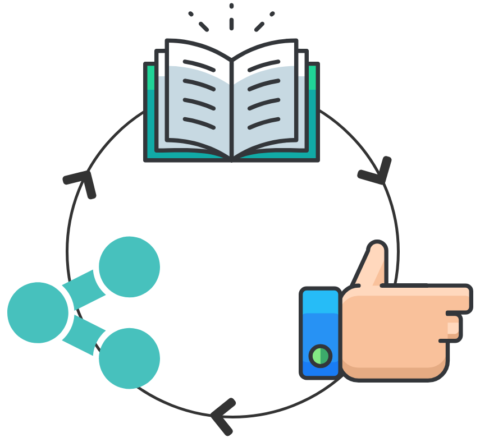
Readable, likeable, shareable content is the basis of convincing the search engines you indeed have authority on a specific topic (i.e., related group of keywords).
Those who best answer searchers’ questions in the most meaningful, entertaining, and technically sound ways are subsequently rewarded with top billing in the search engine results.
In this and despite many beliefs to the contrary, Google’s organic search mandate has never changed; deliver the right results to the right people at the right time.
In other words, context marketing.
When creating a new piece of content or an entire campaign, there are five foundational elements you should be thinking about and clearly defining in order to achieve proper context and overall effectiveness:
- Audience
- Key Questions
- Keyword/Topical Group(s)
- Content Goals
- Measurement
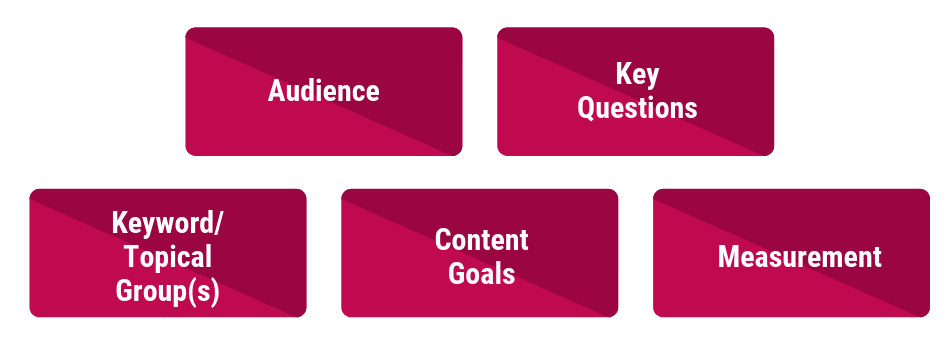
1. Get Intimate with Your Audience
Now, more than ever, it’s crucial to gain a full and broad understanding of the members of your audience.
Regardless of whether your business operates in a B2C or B2B environment, your target customer is a human being.
He, she or they have specific and changing needs, hopes, fears, and priorities.
Perhaps it’s taken too long, but more brands are beginning to realize the basis for successful customer communications is empathy.
Wherever possible, talk to and with your consumers on a human-to-human level.
In order to develop relevant, empathetic content for them you’ll need to gather, at a minimum, the following information:
- Demographics: age, gender, physical location, income.
- Their likes, dislikes, and preferences.
- What are their needs, pains, frustrations, and challenges?
- Where and how do they spend their time online?
- What types of digital content do they prefer to consume? (image-based social media posts, long-form blog posts, short or long videos, podcasts, webinars, etc.)
- What questions are they asking?
2. Content to Answer Their Key Questions
Organic search is still widely recognized as the starting point for most consumer journeys.
Whether they’re searching on Google, Bing, or Amazon or plugging a hashtag into a social network; people are looking for answers to their questions.
Clearly, honestly and accurately answering your consumers’ questions via the content you create addresses the intent of searches they conduct to meet their varied needs, ease their frustrations, or overcome their challenges.
Ann Smarty points out in a recent Content Marketing Institute article that there are three basic types of intent:
- Do (also known as “commercial” or “high” intent): The search user is ready to act (buy, join, etc.).
- Know (also known as “informational” intent): A search user is looking for information.
- Go (also known as “navigational” intent): Search users know which site or brand they want to go to.
Specific content can and should be actively created to address searches based on commercial and informational intent; assuming content for navigational intent already exists.
Informational content, in particular, must be detailed and comprehensive to ensure the questions asked are being fully answered or, if not, linking to the next piece of relevant content with clear direction (call to action) for the consumer to follow.
Content that successfully resolves search intent will be rewarded via return visits from your audience, likes/shares socially, and higher visibility in the search engines.
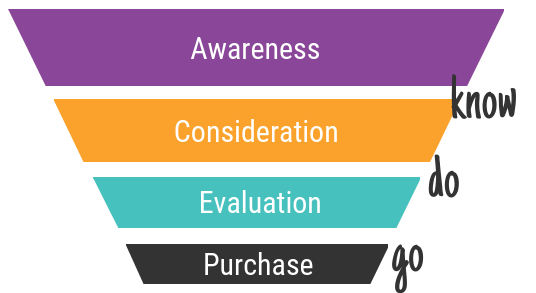
Another way to look at the content you’re creating is relative to your buyer’s journey/sales funnel.
At each stage of the journey, your consumers are looking for a different type of content.
Someone at the top of the funnel, in the awareness stage, is in the process of becoming informed.
They want to “Know” what solutions are available to address their personal or business challenges.
On the other hand, someone at the bottom of the funnel, in the buying or conversion stage, has already completed the awareness and evaluation stages.
This person is ready to “Go” and make a purchasing decision.
Now is a great time to review your content and make sure you have current, relevant content with proper context at each level.
3. Keywords Still Power Content (& Search)
Keywords and phrases remain the underpinning of all content as they are still the primary input for search.
Consumers type or speak single words, multi-word phrases, or detailed questions into search engines to try to find the content and information they desire.
There can be any number of variations of these phrases based on the searcher’s location, mindset, predispositions, and other personal factors.
In short, the way one person thinks and subsequently searches may be radically different from another.
Some of this may come out in the audience development mentioned above.
Therefore, you will want to spend time at the outset of any campaign identifying the topical groups of words and phrases you will want to incorporate into the content you create.
There are several good free and paid tools available to conduct keyword research, but you can start with Google Search Console and your own site search to see which search queries your existing customers are conducting.
4. What Are Your Content Goals
Every piece of content you create should have a purpose or goal, which should fall in line with the aforementioned intent of your consumers and then, in turn, your underlying content strategy.
Creating content without goals in mind is like running in quicksand; a lot of effort spent to go nowhere.
Content goals may include:
- Learning best practices related to your industry and/or the problems you help solve.
- Learning something new about your products or services.
- Learning about new products or services you offer.
- Establishing a point of view or stance on a particular topic.
- Sharing a common experience.
- Random or general entertainment.
- Supporting a buying decision.
- Promoting a special offer and a specific call to action.
Document these goals and assign appropriate metrics to them in order to understand whether your content is effectively addressing them.
5. Measure for Success
Because you’ve established goals for your content, you’ll naturally want to understand whether they’re being met.
Depending on the goal you’ll want to track and report on improvements in:
- Search engine rankings.
- Social proof (i.e., likes, shares, comments).
- Website traffic.
- Conversions (which may or may not include actual purchases).
- Almighty sales a.k.a., ROI.
Everything digital can and should be measured and analyzed.
Here too there are many fine tools available to monitor organic visibility, engagement, and conversion in real-time or report on campaign progress at regular intervals.
Take the time to review your data to determine where to focus your attention moving forward.
Boost those keywords and pieces of content where you’ve established momentum.
Take a hard look at your underperforming keywords and content.
Try to identify why and whether or not it’s worth the time and effort to optimize them further.
Exercise Patience: Content Marketing Success Takes Time
In closing, keep in mind content marketing and search engine optimization are long term strategies.
Both are marathons, not sprints.
Establishing authority on any topic requires time to build the trust and belief of your target audience.
The best path to trust begins with a clear and detailed understanding of their human wants and needs rooted in empathy.
In other words, context marketing.
More Resources:
- What Is Content Marketing & Why It Matters
- Content Marketing: The Ultimate Beginner’s Guide to What Works
- The Difference Between Content Marketing & Content Strategy (& Why You Need Both)
Image Credits
In-Post Images: Mintent

